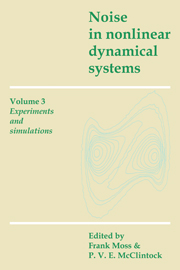Book contents
- Frontmatter
- Contents
- List of contributors
- Preface
- Introduction to Volume 3
- 1 The effects of colored quadratic noise on a turbulent transition in liquid He II
- 2 Electrohydrodynamic instability of nematic liquid crystals: growth process and influence of noise
- 3 Suppression of electrohydrodynamic instabilities by external noise
- 4 Colored noise in dye laser fluctuations
- 5 Noisy dynamics in optically bistable systems
- 6 Use of an electronic model as a guideline in experiments on transient optical bistability
- 7 Computer experiments in non-linear stochastic physics
- 8 Analogue simulations of stochastic processes by means of minimum component electronic devices
- 9 Analogue techniques for the study of problems in stochastic nonlinear dynamics
- Index
8 - Analogue simulations of stochastic processes by means of minimum component electronic devices
Published online by Cambridge University Press: 05 January 2012
- Frontmatter
- Contents
- List of contributors
- Preface
- Introduction to Volume 3
- 1 The effects of colored quadratic noise on a turbulent transition in liquid He II
- 2 Electrohydrodynamic instability of nematic liquid crystals: growth process and influence of noise
- 3 Suppression of electrohydrodynamic instabilities by external noise
- 4 Colored noise in dye laser fluctuations
- 5 Noisy dynamics in optically bistable systems
- 6 Use of an electronic model as a guideline in experiments on transient optical bistability
- 7 Computer experiments in non-linear stochastic physics
- 8 Analogue simulations of stochastic processes by means of minimum component electronic devices
- 9 Analogue techniques for the study of problems in stochastic nonlinear dynamics
- Index
Summary
Introduction
The study of non-linear stochastic processes is usually characterized by considerable difficulties, thereby rendering it necessary to have recourse to computers for the theoretical predictions to be tested. This in turn involves interminable times of calculation with a great waste of money.
Analogue simulation by means of electronic devices allows us to bypass these difficulties. Although the precision of the analogue technique is modest compared to that of computer calculations, it must be remarked that in many cases it is more significant to have available, immediate results rather than very accurate numerical precision.
It is important to underline that the analogue experiment does not completely replace computer simulation; rather, a comparison of the two techniques, wherever possible, has proven to be a powerful method for studying non-linear stochastic phenomena.
In order to give a short description of electronic simulation, a few basic elements of the techniques will be given, then we shall discuss some significant applications. Finally, we shall describe how it is possible to obtain important conclusions via a joint use of computer and analogue simulation. This has been the object of a recent investigation on the role of coloured noise in some dynamical systems.
The basis of the analogue simulation via electronic devices
The integration operation
This operation is usually obtained using an RC-circuit; nevertheless, a Miller integrator, assembled in the configuration shown in Figure 8.1(a) is a better choice because of the following advantages:
(a) The high input impedance allows us to add many input signals.
[…]
Information
- Type
- Chapter
- Information
- Noise in Nonlinear Dynamical Systems , pp. 222 - 242Publisher: Cambridge University PressPrint publication year: 1989
Accessibility standard: Unknown
- 12
- Cited by
